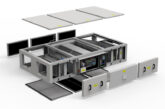
An approved ventilation system is required in the toilet, bathroom, shower, ensuite, utility room and kitchen for all installations that are notifiable work to Building Control. Here the team at Airflow outlines which extractor fan you should install.
The ‘Building Regulations Approved Document F – Ventilation’ sets minimum flow rates that an extractor fan installed in a wet room should be able to deliver when correctly installed. The accompanying Domestic Ventilation Compliance Guide 2010 details “Best Practice” installation methods.
The minimum airflow rates are as follows:
Toilets = 6 l/sec
Bathrooms = 15 l/sec
Utility rooms = 30 l/sec
Kitchens = 60 l/sec (30 l/sec in kitchens when the fan is installed adjacent to the hob – this is also the minimum flow rate expected from a ducted cooker hood).
Excess moisture, often created when these rooms are in use, can result in condensation, damp, and ultimately mould developing if left unchecked.
By having a properly performing extractor fan in these rooms, excess moisture is removed and the conditions allowing mould to form are largely eliminated. However, there isn’t a one-size-fits-all approach regarding the type of extractor fan that you should install.
What type of fan?
Having considered the application of the ventilation required, it is important to select the correct type of fan to meet the requirement fully. Axial Fans are ideal for through the wall, ceiling and short run of ducting applications. Whilst providing high performance from a slim profile, they work against limited back pressure so are recommended for use with flexible ducting not exceeding 1.5m in length, with a maximum of two 90 degree bends.
Mixed flow fans for wall and ceiling combine the convenience of the size of an axial fan with the performance of a small centrifugal fan, making them ideal for short to medium duct runs. Centrifugal fans are quiet, powerful and suitable for wall and ceiling applications.
They work well against system resistance, making them the perfect choice for efficient performance for longer duct runs.

Installed performance
It’s not sufficient to just fit any fan. The selected fan should perform efficiently by extracting the minimum flow rate as required by the latest Building Regulations.
The number of bends and the length of duct attached to the fan will create resistance to flow that must be overcome to ensure adequate extraction, known as ‘installed performance’.
Fans should also be positioned to give an optimum flow of air through the whole room and, to avoid pockets of residual air, they should be mounted as high as possible, well away from primary heat sources such as gas water heaters and boilers.
To optimise ventilation of a bathroom it may not be beneficial to rely on a window to supply the replacement air. This is subject to the proximity of the fan to the window.
You must also consider the location of planned or existing door and window openings, as well as sources of odours, stale air or condensation. Undercutting of doors and use of trickle vents is required by the Building Regulations to allow air into the room.
For more information about the range of fans from Airflow, visit: www.airflow.com









